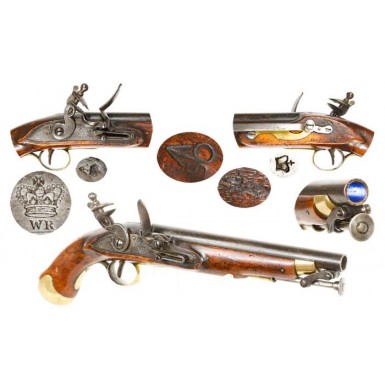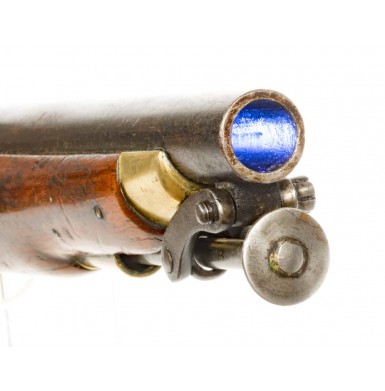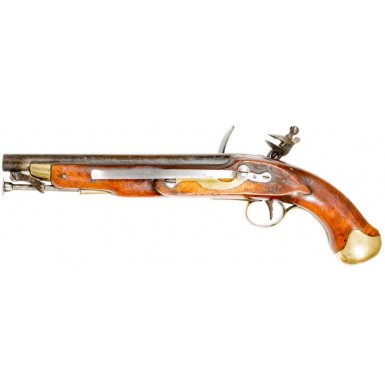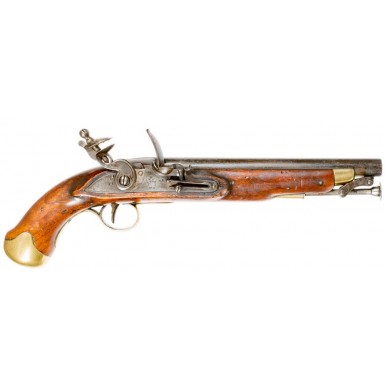This is a VERY FINE condition example of a British Pattern 1824 Sea Service Pistol, a gun that has languished misidentified for many years. The outward resemblance to the New Land Pattern cavalry pistol that was adopted by the British Board of Ordnance circa 1802-1803 has long resulted in these pistols being identified as “New Land Pattern Sea Service Pistol” or some other similar misnomer. The New Land Pattern Pistol evolved through numerous minor pattern changes over the next three decades but remained the standard form of cavalry pistol for the British military into the percussion era. The pistol was hardly as elegant as its predecessors but was a very serviceable handgun. It was a single shot, smoothbore, muzzleloading flintlock with pinned 9-inch barrel, a captive swivel ramrod and flat, India Pattern type lock. The furniture was of brass, which included a simple lobed buttcap, a flat S-shaped side plate, a simple triggerguard and a brass nose cap. By about 1805 a waterproof pan was introduced and by 1810 a bolted safety was introduced and experimented with form some time. The earliest guns were produced with bright metal components, with browning adopted circa 1815 and bluing experimented with towards the end of production. While the early production guns retained some rudimentary stock carving, most notably a simple apron around the breech plug tang, later production guns eliminated this feature; likely due to production pressures during the height of the Napoleonic Wars. One of the primary features of the New Land Pattern pistols were that they were produced in carbine bore, nominally about .65 caliber. This allowed the shared use of ammunition (balls) between some of the carbines then in use and the pistols. During the same period pistol bore was nominally about .57 caliber. For decades, this smaller caliber had been standard for British naval pistols. It is this very feature that is one of the key identifying features for the Pattern 1824 Sea Service Pistol. The Model 1824 Sea Service Pistol outwardly resembles the New Land Pattern Pistol, with the only obvious difference being the addition of naval pattern belt hook on the reverse. It is this belt hook that has resulted in many references referring to the guns as “New Land Pattern Naval Pistols” or something similar. However, an examination of the bore reveals that they are “pistol bore” and not “carbine bore”, so they are not Land Pattern guns. The Royal Navy had been using their 12” barreled Pattern 1801 Sea Service pistols for nearly two-decades when in 1816 it was decided to shorten the barrels of the pistols to 9.1”, creating the Pattern 1801/16 pistol. In 1821, a new, simplified Sea Service pistol was introduced, which utilized some of the New Land Pattern furniture, a flat East India Company pattern lock and an iron button-head ramrod. Based upon the research of English arms author and historian DeWitt Bailey a new pattern was authorized in 1824. These pistols were set up at the Royal Small Arms Manufactory at Enfield, with his research indicating that 800 pairs (1,600 guns) were assembled. The guns were for all practical purposes pistol bore New Land Pattern Pistols with belt hooks but were considered a separate pattern pistol. The guns has 9” pinned barrels, a flat India Pattern style lock with a fenced, waterproof pan and a flat reinforced cock, a captive swivel ramrod and a 5 ¾” long belt hook that was 7 ¼” in overall length. The initial pistols may have been browned, but as with late production Land Pattern Pistols, many had blued barrels. The Pattern 1824 Sea Service Pistol would serve until the percussion era, with some newly produced percussion Sea Service pistols starting to see service before the end of William IV’s reign in June 1837 when he died. The British Pattern 1824 Sea Service Pistol offered here is in VERY FINE condition. The gun is 100% complete, correct and original with no repairs or replacement parts. The gun is clearly marked on the lock with the British Crown over WR for William IV, who reigned from 1830-1837. This would seem to be fairly late production for such a small order of Pattern 1824 pistols but may be the result of some sort of arsenal rebuilding program or simply the result of additional group of pistols being set up during the early 1830s. The lock is additionally marked with the expected Crown-Broad Arrow inspection below the pan. British military proofs are present on the barrel near the breech and a very clear BROAD ARROW-BO (Board of Ordnance) mark is present behind the flat on the upper left wrist. Inspection marks are present on the lower right side of the grip with additional CROWN inspection marks on the belt hook and swivel ramrod. The stock flat is additionally marked with a CROWN / P and W inspection. The pistol bears matching assembly marks throughout. The file slash mating mark \ \ \ | | | is found on the top edge of the lock, on both lock mounting screws, on the ramrod, in the ramrod channel and on the belt hook. Due to the crisp stock I did not drive out the pins to look under the barrel. The interior of the lock is additionally marked with a CROWN / 6 inspection. The lock remains in its original flintlock configuration as does the barrel, and neither is a reconversion from percussion. The lock remains in fine mechanical condition and functions crisply on all positions. The .56 caliber smooth bore remains in FINE condition as well, with some lightly scattered oxidation and no significant pitting to speak of. The pistol retains much of what appears to be its period applied rough blued finish, with some thinning and wear and a slightly streaky appearance. This may be an arsenal refurbished finish, as the barrel markings are slightly light, but matches the finish found on other high condition examples of this pattern of pistol perfectly. The barrel does show some lightly scattered surface oxidation and some minor flecks of pitting, but nothing serious. The brass furniture has a very attractive medium golden patina. The stock remains extremely crisp with sharp edges and lines and some areas of feathery grain. The stock has never been sanded, with all markings remaining clear and crisp. The stock is solid, full-length and free of any breaks or repairs. There are a couple of tiny, tight surface grain cracks preset that are barely noticeable. One is about ½” long on the obverse at the nose cap, just above the rammer channel. There are also a flanking pair, about 1” long on either side of the ramrod entry to the stock, emanating from the entry pipe. Both are tight and secure and are barely even noticeable but are mentioned because the stock is in such fine condition. Otherwise, the stock shows only some lightly scattered minor bumps, dings and light impact marks from storage and use. Overall, this is a VERY FINE condition example of a fairly scarce British Pattern 1824 Sea Service Pistol. The gun remains crisp and sharp throughout, is well marked and remains in a really wonderful state of preservation. This would be a wonderful addition to any collection of British martial flintlock pistols or British naval small arms. It is a historically important firearm as one of the last of the official British military official pattern flintlock pistols, and likely the last of the British naval flintlock handguns. This would be a wonderful addition to your collection and is a pistol not often seen for sale, particularly in this condition. ON HOLD |












